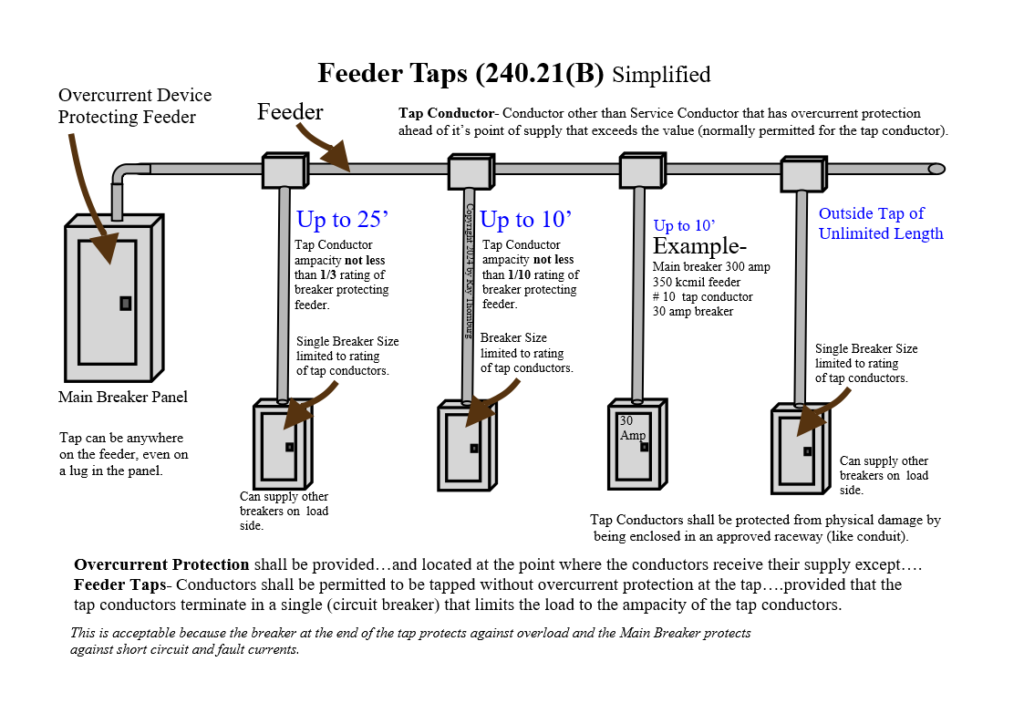In this article I want to clear up some confusion about a wiring method home inspectors sometimes encounter and which sometimes even some electricians don’t thoroughly understand. I’m talking about section 240.21(B) of the NEC (National Electrical Code) which discusses Feeder Taps. While most people understand that overcurrent protection is typically required at the point where the conductors receive their power; they’re not aware that there are exceptions. Well, we don’t want anyone scratching their heads so let’s get on with our discussion on Feeder Taps.
Let’s start with some definitions-
- Service Conductor– The conductors from the service point to the service disconnecting means (Main Breaker Typically).
- Feeder Conductors– All circuit conductors between the service equipment, the source of a separately derived system or other power supply source and the final branch circuit overcurrent device.
- Tap Conductor– A conductor other than a service conductor that has overcurrent protection ahead of its point of supply that exceeds the ampacity value normally permitted for that sized conductor (tap conductor).
- Branch Circuit- The circuit conductors between the final overcurrent device protecting the circuit and the outlet(s).
Now let’s study the diagram below to understand the essential pieces of the puzzle.
Classifications of Feeder Taps
Although article 240.21(B) discusses 5 classifications of feeder taps we’re only going to discuss sections 1, 2 and 5. I encourage anyone interested to read the appropriate section of the NEC for the fine points on these sections.
Taps Not Over 10 feet Long- Key Points-
- The ampacity of the tap conductors cannot be less than the calculated load supplied by the tap conductors and…
- Not less than the rating of the overcurrent device at the termination of the tap conductors or the device supplied by it.
- Tap conductors must be protected in a raceway (like approved conduit).
- The rating of the overcurrent device on the line side of the tap conductors shall not exceed 10 times the ampacity of the tap conductor.
Taps Not Over 25 feet Long- Key Points-
- Tap conductor length always refers to the conductor length and not the length of the conduit.
- Always remember you are not allowed to tap a tap conductor.
- The ampacity of the tap conductors is not less than 1/3rd the rating of the overcurrent device protecting the feeder conductors.
- The tap conductors terminate in a single overcurrent device that limit the load to the ampacity of the tap conductors. This device shall be permitted to supply any number of additional overcurrent devices on its load side.
- The tap conductors must be protected in an approved raceway or other approved means.
Outside Taps of Unlimited Length- Key Points-
- Used where the conductors are located outdoors of a building or structure, except at the point of termination.
- Conductors are protected from physical damage in an approved manner.
- The conductors terminate at a single circuit breaker or a single set of fuses that limit the load to the ampacity of the conductors. This single overcurrent device shall be permitted to supply any number of additional overcurrent devices on its load side.
- The overcurrent device is an integral part of the disconnecting means or shall be located immediately adjacent thereto.
- The disconnecting means is located at a readily accessible location outside the building, or inside nearest the point of entrance of the conductors.
Electricians often use feeder taps for a variety of reasons.
- Cost- It can be less expensive to tap into an existing feeder.
- Panel Space- Tapping a feeder might be needed if there is limited space in an electrical panel or all the breaker slots are filled.
- Flexibility- In some cases tapping a feeder is simply easier than running a cable around the other side of the home for instance.
- Safety- Complying with the rules creates a safe way to extend your electrical needs.
Conclusion
Feeder taps are often found on remodeled homes, or homes with detached structures. Inspectors should be on the lookout for this wiring method to properly spot safety concerns.
For more information see our article on Panels, Subpanels and local disconnects.
Also visit our page about Grounding and Bonding.


